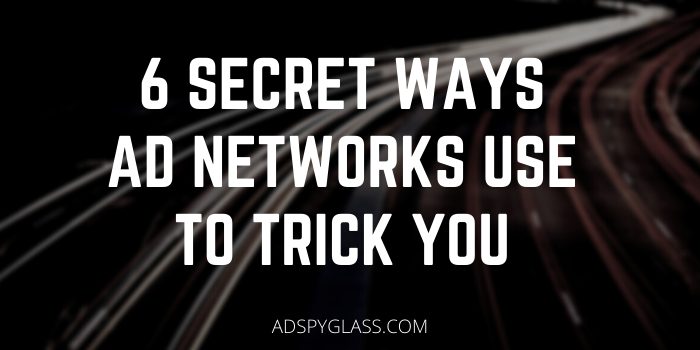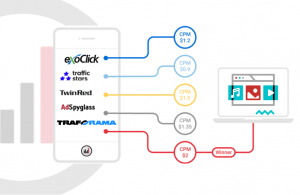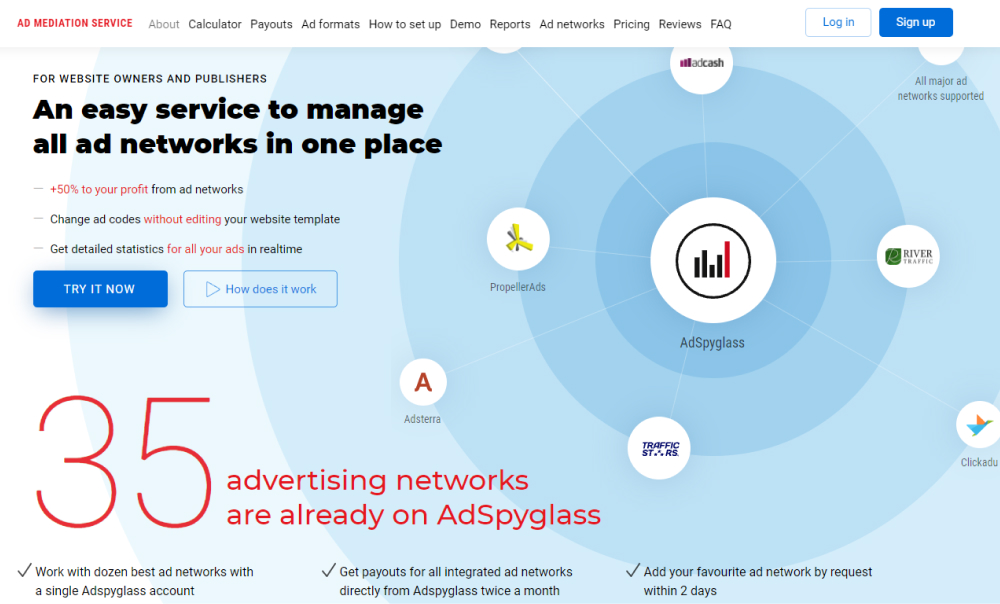In this guide, we analyze 6 hidden ways that Ad Networks can trick publishers and webmasters. We’ll tell you, how this can affect your website and how to discover and prevent it.
Of course, we aren’t talking about all networks here. It is only about some of them. But when it comes to traffic monetization, it’s important to check everything you can.
Enjoy the reading and feel free to share below some pieces of your experience of working with ad networks.
Why Ad Networks might be not 100% trustworthy
As you may know, Ad Networks serve both the needs of publishers and mediation systems. However, it happens that customers leave the Ad Network even though it provides a high-quality service. That’s why some Ad Networks prefer to get as much profit from the publishers as possible before they say goodbye. What about the work with the mediation system, it’s always about a long-term alliance, and it requires more clarity and trustworthiness from networks.
Not all networks use this kind of technique. But you need to keep in mind that some are trying to take their advantage.
Just imagine: if you want to crush those abs, you’re likely to figure out first what types of workout can help you target that specific type of muscle. Similarly, if you are willing to be a wise webmaster, you need to know all the traps of Ad Networks to avoid those, don’t you?
This way, you will narrow down your choice of networks and mediation services to partner with and pick only those that help you grow income and maintain a good amount of website traffic.
As you know, the Ad Network manages both stats and ads. Therefore, there’re a few tricks they can pull to boost their revenues and keep this info hush-hush from their clients.
You may wonder what the secret is. To start, if you have a third-party JS code running on your website, Ad Network can play with numbers. Why? Because you no longer have control over what’s going on – this is controlled by the code owner.
But don’t freak out. If you thoroughly researched a network to partner with, you’re unlikely to end up in such a situation. However, if you decided to choose a random one, it might cost you.
Pay attention to these red flags to have control over your cash flow.
Multi-format
Banner, vast, push, or a popunder – these are ad types that can appear on your website. Before it gets down to actual work, the Ad Network will discuss your preferences, and you’ll pick the exact format of ads.
But you know what else? One single JS-tag can change the game: with this maneuver, ad networks can choose whatever ad format they want, and you won’t find out about it.
Watch out: oftentimes, a JS code, or alternatively a popunder go along with native banners.
So even though you’ve earlier decided that you want to see either a push or a popunder on your site, both of them can be shown to your audience, and that’s the sign you’re being tricked. Using this technique, Ad Network can grow its stakes at publishers’ expense.
One more thing to remember: be especially careful if the fixed CPM and flat rate look too attractive. These juicy numbers tell you about multi-format advertising that is happening. Why do I say this? It’s a chance for Ad Network to propose a very good rate for a publisher that doesn’t know the nature of it (very high CPM). Thus, Ad Networks manage to make extra bucks, but for themselves.
To keep this side business a secret from a client, Ad Networks cover their tracks. Do you want me to tell you exactly how? Once the JS code is there on the site, Ad Networks track down the IP address and the geo of a publisher that can control whether he wants multiple ad types for his locality. Also, Ad Networks can exclude regions where those extra ad formats can be seen by the competition.
Finally, advertising networks can go even further: they’d block additional ads placed even for VPN traffic, so you won’t know what is going on if you decide to use a private network connection instead of a regular one.
In fact, with multi-format advertising, Ad Networks can sometimes double their income or go far beyond this number.
Read also Mediation Services or How To Maximize Your Website Profit
Frequency capping
Next, the Ad Network can manipulate the frequency with which each ad is shown to a user. For instance, you set a certain number of times a banner is going to appear. Knowing about your IP and geo, the Ad Network chooses the locations where it can change the restrictions completely and not get busted.
Ad Networks have the technical ability to increase frequency capping. They can keep it quite reasonable for one geo location in Europe, and set it sky-high for North America.
But that’s not the worst. Exaggerated frequency capping of a popunder can negatively impact your website ranking. Why is this so? Google’s Coalition for Better Ads says that websites that do not comply with the rules will be excluded from a search.
Then again, imagine how your regular users would feel were they shown the same popunder all the time. Oddly enough, because of the unethical business practice of your ad partner, your reputation is at stake.
Hidden stats aka Shaving
How often do you see the stats other than what your Ad Network partner shows you? Think about it for a second: Ad Networks can keep out of sight a part of traffic coming from a certain IP address, and you won’t even know you had those users checking your website and ads on it.
No traffic shown means the Ad Network can keep that money. Another way of cheating: they hide a part of statistics but not revenue. It artificially increases CPM and helps to attract more clients who think that a high cost of impressions is the way to huge profit.
To solve the mystery with stats, you can rely on your webmaster, who ideally would use additional tools to track and measure website traffic.
Redirect
Remember we earlier spoke about a third-party JS-code, and what having it means for your website? It has another possible disadvantage for you. So what’s going on?
That same JS-code can turn the traffic away from your site. Some websites are ready to pay for visitors, and that is good money according to some Ad Networks.
Let’s look at numbers: the Ad Network is paid 6 cents for 1000 impressions; it gives you your cut of 4 cents and keeps the remaining 2 cents to itself. However, if it manages to chop off some of your traffic, it can push it to those in need and desperate to increase their audience for as much as $1.
Fact: Ad Networks would act very carefully not to get caught, so they’re likely to steal only a tiny portion of your traffic. They play their cards right and offer very attractive conditions to publishers. It’s a sign: if you see a banner with suspiciously high CPM (like times higher than usual), something is wrong.
Unfortunately, the redirect has another negative side effect: your website visitors will be furious after a few redirects to a totally different unrelated website. So you’ll just lose them for good.
Customer data management
Now let’s take a closer look at push ads. When website users give their consent to you to send them notifications, they will be viewing anything you send plus ads. Even when they don’t browse your site, the pop up can appear on a smartphone or desktop.
If JS code is used to send those push ads, customers’ personal details are gathered and kept on servers that you, as a publisher, won’t have access to. This means you can no longer control what, when and how many ads will appear on their screens. A network might spam users until they get tired of this and block you.
And another thing: in case you’d want to find another Ad Network to partner with, you won’t be able to take your customer database with you. But the saddest part is your users might get spammed even after you finish your contract with the network.
We’ve got a suggestion for you to prevent this from happening: make sure you (not anyone else) collect your customer data and keep it safe.
Aggressive advertising
Do you recall the last time you wanted to read an article or watch that funny puppy biting its tail video, but couldn’t because first you were prompted to leave your email address and sign up for updates? How did it make you feel? I bet you were irritated a bit.
What’s more: you might get messages about fake virus alerts. This is a road to nowhere: Google might exclude such sites from search and users would leave and never come back again.
As you know from earlier info, Ad Networks are tricky enough to hide these aggressive ads from publishers even for particular locations and even when VPN is used.
How to spot unethical Ad Networks
To figure out whether your ad partner uses JS-code to trick you, it makes sense to see from different locations how your website appears and how it looks on different screens; if you cannot do it yourself, ask friends and acquaintances abroad for help.
If that doesn’t work, there’s a chance you can detect those malicious practices by employing third-party tools that designed specifically to look for unethical activity on websites being it aggressive advertising or some undesired ad formats.
These vendors can test site performance from several geo locations, gadgets, etc – they have their own tool kit and resources to perform these thorough checks.
But one thing’s for sure: these services are quite expensive. Not all publishers can afford them.
Read also Four Ways to Monetize an Adult Tube Site
Steps to protect your website from possible harm
Let us recap all the things we’ve discussed, so you have your action plan to deal with fraudulent Ad Networks.
- Don’t place any JS-code on your site unless you’re 100% sure what it exactly does and that its work won’t harm your business.
- Place banners using the iframe function.
- Take care of customer data collection and management exclusively ‘inhouse’ and don’t let anyone do that on your behalf.
- Remember about collecting and monitoring stats to have it later compared with what your Ad Network partner shows you.
And you know what? All-in-one solution to all your pains could be to actually use a mediation system. This player will have all the points covered – alternative stats, methods to gather push database, its own code to go along popunders and so much more.
No need to giving away control of the site. The powers to manage your website will be in your hands.
Mediation systems let you check all advertising parameters and therefore avoid any type of content which could damage your website.
And keep in mind, the result of the whole process should be measured in traffic numbers and income, that’s for sure.
Not enough information? Watch our demo video, “how it works” video or read the AdSpyglass review.
Read also: What is ad mediation and how does it work
Read also: SEO for Adult Sites – How to Drive Organic Traffic
And compare all ad networks CPM rates by countries here: Top Ad Networks







